
- SAP Community
- Groups
- Interest Groups
- Application Development
- Blog Posts
- ABAP CDS Consumption View Features Ultimate Test: ...
- Subscribe to RSS Feed
- Mark as New
- Mark as Read
- Bookmark
- Subscribe
- Printer Friendly Page
- Report Inappropriate Content
- Currency Translation
- Display of Currencies and Units of Measure
- Use of Attributes
- Use of Texts
- Use of Hierarchies
- Use of Variables
- Use of Calculated Key Figures
- Use of Restricted Key Figures
- Use of functions like NDIV0 and NODIM
- Use of Time Dependent Dimensions and Hierarchies
- Use of language dependent texts
- Percentage Share calculation
- Exception aggregation using Formula and Count
- Filtering Key Figures Structure
- Setting Key Figure attributes like number of decimals
- Setting Description (Variables, Characteristics, Key Figures, etc)
- Setting Variable value dynamically
- Defining Layout (rows, columns and free characteristics) and switching on hierarchy
So for my ultimate test I built my Flight Y2Y comparison ABAP CDS Consumption View from ground up starting from BASIC views to prepare data, then created TEXT, HIERARCHY, DIMENSION, FACT and CUBE view then finally built by CONSUMPTION view. I will not go much into details of implementation because all that you can explore on your own. What is more important is to understand ABAP CDS Consumption Views capabilities.
This is what I have got:
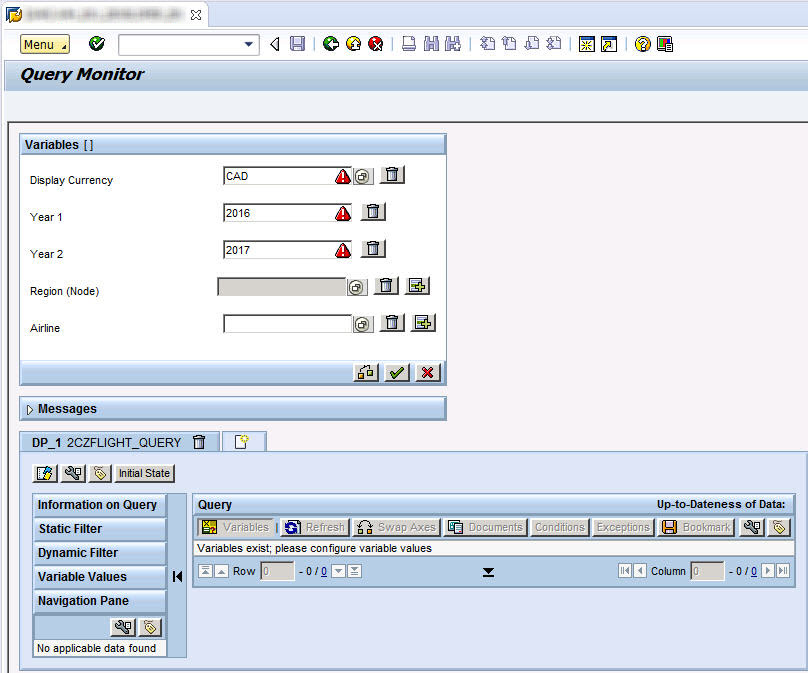
As you can see from screen shot above it is possible to create hierarchy (Region) and characteristic variables. Also parameters for currency conversion (Display Currency) and restricted key figures restrictions (Year 1 and Year 2).
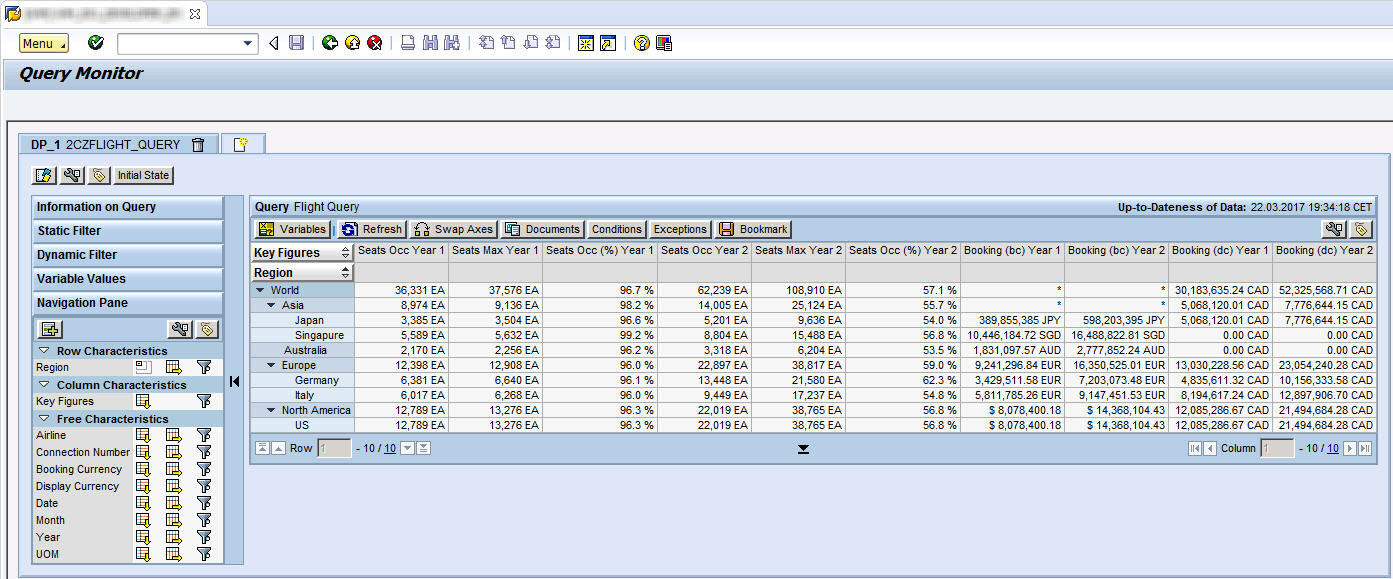
As you can see from screen shot above it is possible to do:
- Convert currencies (dc e.g. display currency columns)
- Create restricted columns (Year 1 and Year 2)
- Create calculated columns (Seats Occupied %)
- Activate hierarchy (region characteristic)
- Display unit of measures (currency, quantity and % for formula)
- Set number of decimal places (1 for Seats Occupied % columns)
- Characteristics and Key Figures are given proper descriptive names
Lets see hierarchy node selection variable in action

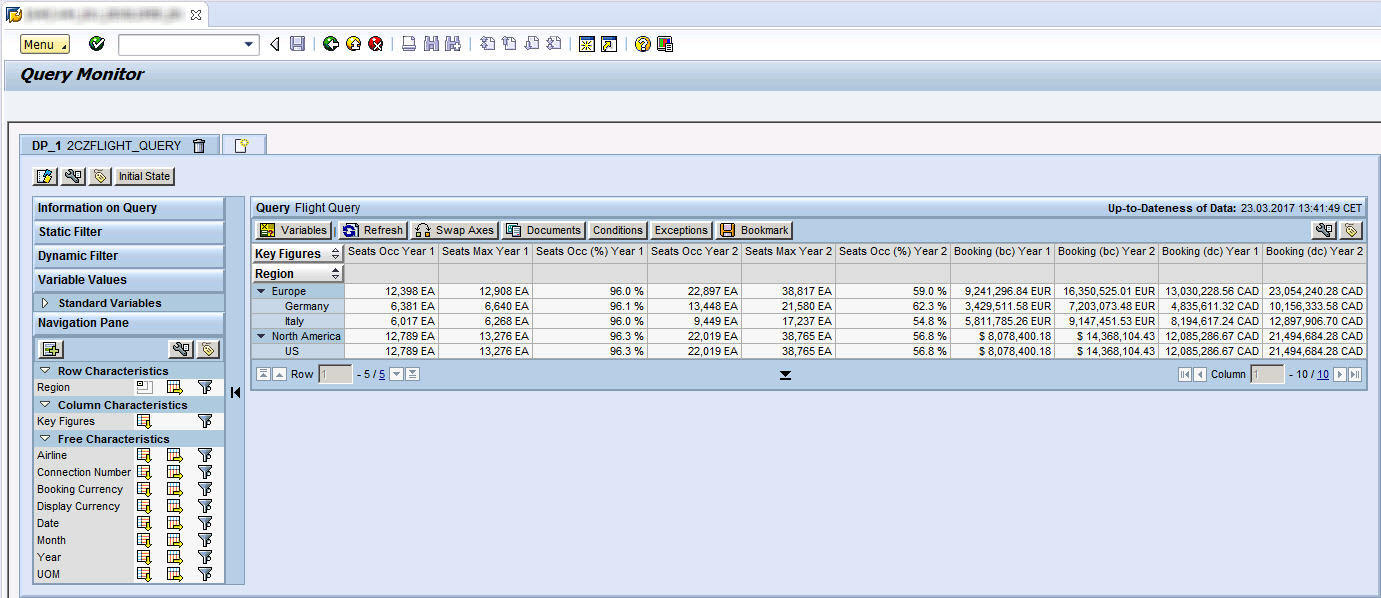
As you can see from above screen shot node variable filtered hierarchy to Europe and North America data
Let me swap Region with Airline and display some more capabilities
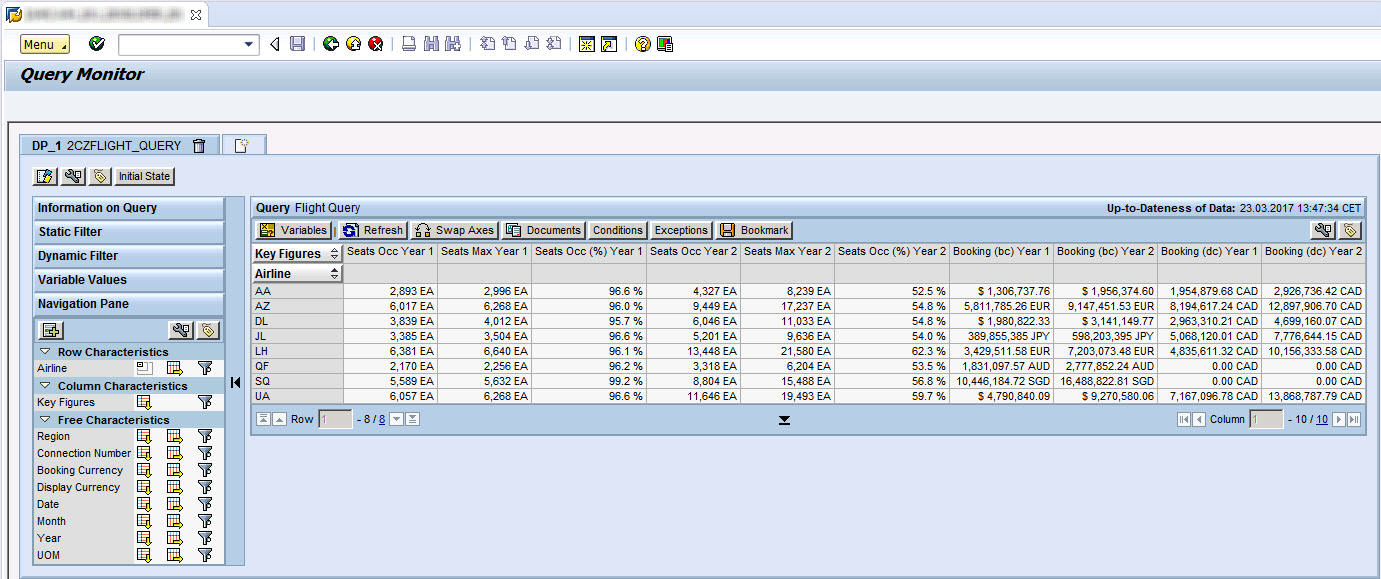
From Airline characteristic properties presentation can be changed as well as attribute display activated

As you can see from screen shot above it is possible to:
- Activate display of characteristic attribute (URL)
- Change characteristic presentation (key and text)
Finally lets test characteristic variable
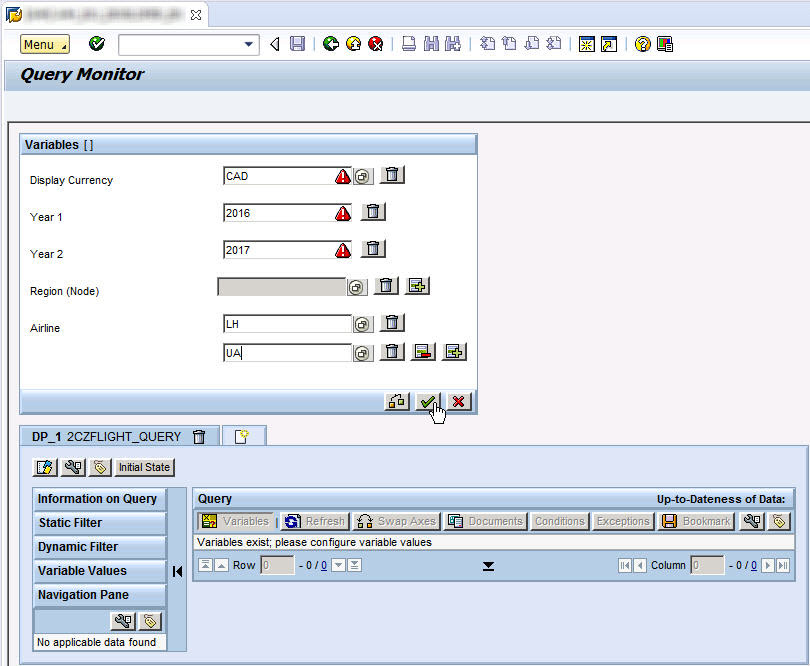
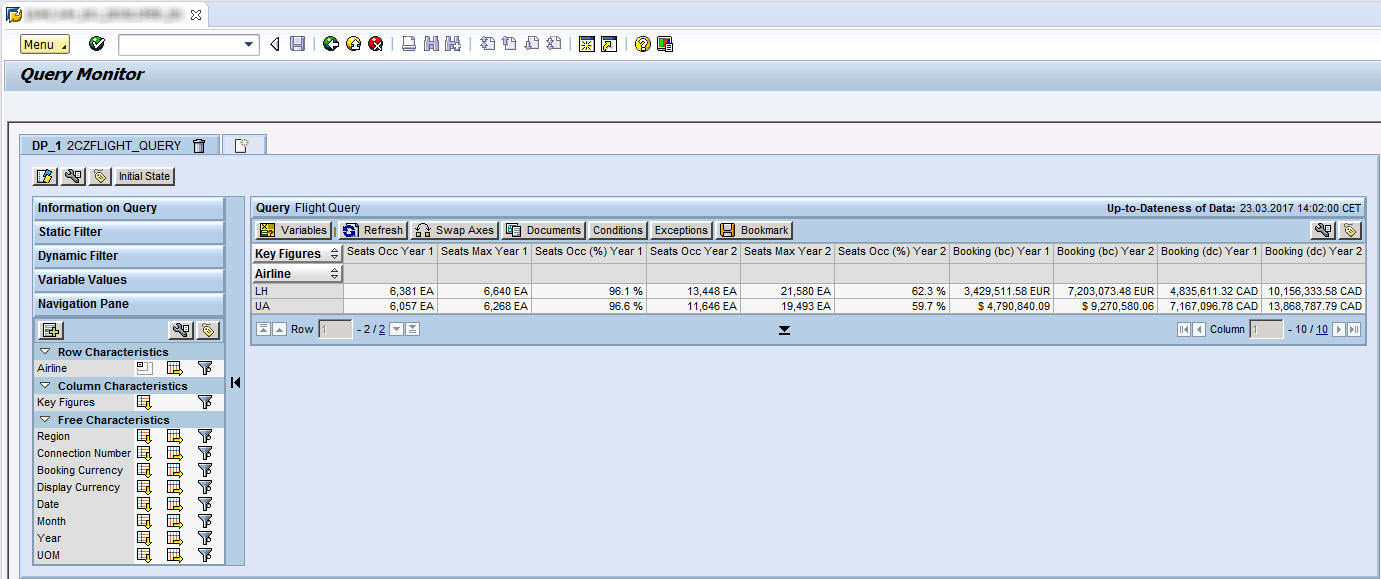
As you can from above screen shot Airline characteristic variable is working limiting data to LH and UA.
You can create demonstrated ABAP CDS Consumption View and all other underlying view using source code below.
BASIC Views:
ZSAPBC_CARR
@AbapCatalog.sqlViewName: 'ZCARR'
@AccessControl.authorizationCheck:#NOT_REQUIRED
@EndUserText.label: 'Airline'
defineview zsapbc_carr asselectfrom scarr
{
carrid,
url,
currcode,
cast(case
when carrid ='LH'or carrid ='AB'then'Germany'
when carrid ='AA'or carrid ='CO'or carrid ='DL'or
carrid ='NW'or carrid ='WA'then'US'
when carrid ='AC'then'Canada'
when carrid ='AF'then'France'
when carrid ='AZ'then'Italy'
when carrid ='BA'then'UK'
when carrid ='FJ'then'Fiji'
when carrid ='NG'then'Austria'
when carrid ='JL'then'Japan'
when carrid ='QF'then'Australia'
when carrid ='SA'then'South Africa'
when carrid ='SQ'then'Singapure'
when carrid ='SR'then'Swirzerland'
when carrid ='UA'then'US'
else'Other'
endas abap.char(13)) as region
}
ZSAPBC_REGION
@AbapCatalog.sqlViewName: 'ZREGION'
@AccessControl.authorizationCheck:#NOT_REQUIRED
@EndUserText.label: 'Flight - Region'
define view zsapbc_region as select distinct from zsapbc_carr {
key region,
case
when region = 'Germany' or region = 'France' or region = 'Italy' or
region = 'UK' or region = 'Austria' or region = 'Swirzerland' then 'Europe'
when region = 'US' or region = 'Canada' then 'North America'
when region = 'South Africa' then 'Africa'
when region = 'Fiji' or region = 'Japan' or region = 'Singapure' then 'Asia'
else 'Other'
end as main_region
}
where region <> 'Australia'
union
select distinct from scarr {
key 'Europe' as region,
'World' as main_region
}
union
select distinct from scarr {
key 'North America' as region,
'World' as main_region
}
union
select distinct from scarr {
key 'Asia' as region,
'World' as main_region
}
union
select distinct from scarr {
key 'Australia' as region,
'World' as main_region
}
union
select distinct from scarr {
key 'Africa' as region,
'World' as main_region
}
union
select distinct from scarr {
key 'World' as region,
'' as main_region
}
TEXT, HIERARCHY, DIMENSION Views:
ZSAPBC_CARR_TEXT
@AbapCatalog.sqlViewName: 'ZCARR_TEXT'
@analytics: {dataCategory: #TEXT, dataExtraction.enabled: true}
@AccessControl.authorizationCheck: #NOT_ALLOWED
@EndUserText.label: 'Flight - Carrier Text'
define view zsapbc_carr_text as select from scarr {
key carrid,
@Semantics.text: true
carrname as CarrierName
}
ZSAPBC_CARR_DIMENSION
@AbapCatalog.sqlViewName: 'ZCARR_DIM'
@analytics: {dataCategory: #DIMENSION, dataExtraction.enabled: true}
@ObjectModel.representativeKey: 'CARRID'
@AccessControl.authorizationCheck: #NOT_REQUIRED
@EndUserText.label: 'Flight - Carrier Dimension'
define view zsapbc_carr_dimension as select from zsapbc_carr as scarr
association [1..1] to zsapbc_carr_text as _carr on $projection.carrid = scarr.carrid
{
@ObjectModel.text.association: '_carr'
key carrid,
url,
currcode,
@EndUserText.label: 'Region'
region,
_carr
}
ZSAPBC_REGION_HIERARCHY
@AbapCatalog.sqlViewName: 'ZREGION_HIER'
@analytics: { dataCategory: #HIERARCHY, dataExtraction.enabled: true }
@ObjectModel.representativeKey: 'REGION'
@AccessControl.authorizationCheck: #NOT_REQUIRED
@EndUserText.label: 'Flight - Region Dimension'
@Hierarchy.parentChild.name: 'REGION_GEO'
@Hierarchy.parentChild.label: 'Region Geography'
@Hierarchy.parentChild: { recurse: {
parent: 'ParentNode', child: 'HierarchyNode' } }
define view zsapbc_region_hierarchy as select distinct from zsapbc_region
association[0..1] to zsapbc_region_dimension as _region_dim on $projection.HierarchyNode = _region_dim.region
{
@ObjectModel.foreignKey.association: '_region_dim'
key region as HierarchyNode,
main_region as ParentNode,
_region_dim
}
ZSAPBC_REGION_DIMENSION
@AbapCatalog.sqlViewName: 'ZREGION_DIM'
@analytics: { dataCategory: #DIMENSION, dataExtraction.enabled: true }
@ObjectModel.representativeKey: 'REGION'
@AccessControl.authorizationCheck: #NOT_REQUIRED
@EndUserText.label: 'Flight - Region Dimension'
define view zsapbc_region_dimension as select from zsapbc_region
association[0..*] to zsapbc_region_hierarchy as _region_hier on
$projection.region = _region_hier.HierarchyNode
{
@ObjectModel.Hierarchy.association: '_region_hier'
key region,
@EndUserText.label: 'Main Region'
main_region,
_region_hier
}
FACT View:
ZSAPBC_FLIGHT_FACT
@AbapCatalog.sqlViewName: 'zsflight_fact'
@AbapCatalog.compiler.compareFilter: true
@Analytics.dataCategory: #FACT
@AccessControl.authorizationCheck:#NOT_REQUIRED
@EndUserText.label: 'Flight Fact'
define view zsapbc_flight_fact with parameters
@Consumption.defaultValue: 'CAD'
p_display_currency : s_currcode
as select from sflight inner join zsapbc_carr as scarr on sflight.carrid = scarr.carrid {
key sflight.carrid,
key sflight.connid,
key sflight.fldate,
scarr.region,
cast(substring(sflight.fldate,1,6) as abap.numc( 6 )) as flmonth,
cast(substring(sflight.fldate,1,4) as abap.numc( 4 )) as flyear,
sflight.currency,
sflight.paymentsum as payment,
'CAD' as disp_curr,
currency_conversion(
amount => sflight.paymentsum,
source_currency => sflight.currency,
target_currency => $parameters.p_display_currency,
exchange_rate_date => sflight.fldate,
exchange_rate_type => 'M',
error_handling => 'SET_TO_NULL'
) as payment_disp_curr,
cast('EA' as abap.unit(3) ) as unit,
sflight.seatsmax,
sflight.seatsmax_b,
sflight.seatsmax_f,
seatsmax + seatsmax_b + seatsmax_f as seatsmax_total,
sflight.seatsocc,
sflight.seatsocc_b,
sflight.seatsocc_f,
seatsocc + seatsocc_b + seatsocc_f as seatsocc_total
}
CUBE View:
ZSAPBC_FLIGHT_CUBE
@AbapCatalog.sqlViewName: 'ZSFLIGHT_CUBE'
@AbapCatalog.compiler.compareFilter: true
@analytics: { dataCategory: #CUBE, dataExtraction.enabled: true }
@AccessControl.authorizationCheck:#CHECK
@EndUserText.label: 'Flight Cube'
define view zsapbc_flight_cube with parameters
p_display_currency : s_currcode,
p_year_1: rscalyear,
p_year_2: rscalyear
as select from zsapbc_flight_fact( p_display_currency:
$parameters.p_display_currency ) as flight
association [1..1] to zsapbc_carr_dimension as _carr on $projection.carrid = flight.carrid
association [1..1] to zsapbc_region_dimension as _region on $projection.region = flight.region
{
@ObjectModel.foreignKey.association: '_carr'
key flight.carrid,
key flight.connid,
@EndUserText.label: 'Date'
key flight.fldate,
@EndUserText.label: 'Region'
@ObjectModel.foreignKey.association: '_region'
@ObjectModel.Hierarchy.association: '_region'
flight.region,
_carr,
_region,
@Semantics.calendar.yearMonth: true
@EndUserText.label: 'Month'
flight.flmonth,
@Semantics.calendar.year: true
@EndUserText.label: 'Year'
flight.flyear,
@Semantics.currencyCode: true
@EndUserText.label: 'Booking Currency'
flight.currency,
@Semantics.amount.currencyCode: 'Currency'
@DefaultAggregation: #SUM
@EndUserText.label: 'Booking (bc)'
flight.payment,
@Semantics.quantity.unitOfMeasure: 'Currency'
@DefaultAggregation: #SUM
@EndUserText.label: 'Booking (bc) Year 1'
case when flyear = :p_year_1 then payment
else 0
end as payment_year_1,
@Semantics.quantity.unitOfMeasure: 'Currency'
@DefaultAggregation: #SUM
@EndUserText.label: 'Booking (bc) Year 2'
case when flyear = :p_year_2 then payment
else 0
end as payment_year_2,
@EndUserText.label: 'Display Currency'
cast('CAD' as abap.cuky( 5 )) as disp_curr,
@Semantics.amount.currencyCode: 'disp_curr'
@EndUserText.label: 'Booking (dc)'
@DefaultAggregation: #SUM
flight.payment_disp_curr,
@Semantics.quantity.unitOfMeasure: 'disp_curr'
@DefaultAggregation: #SUM
@EndUserText.label: 'Booking (dc) Year 1'
case when flyear = :p_year_1 then payment_disp_curr
else 0
end as payment_disp_curr_year_1,
@Semantics.quantity.unitOfMeasure: 'disp_curr'
@DefaultAggregation: #SUM
@EndUserText.label: 'Booking (dc) ear 2'
case when flyear = :p_year_2 then payment_disp_curr
else 0
end as payment_disp_curr_year_2,
@Semantics.unitOfMeasure: true
@EndUserText.label: 'UOM'
flight.unit,
@Semantics.unitOfMeasure: true
@EndUserText.label: '%'
cast( '%' as abap.unit( 3 ) ) as unit_percent,
@Semantics.quantity.unitOfMeasure: 'unit'
@DefaultAggregation: #SUM
@EndUserText.label: 'Seats Max Econ.'
flight.seatsmax,
@Semantics.quantity.unitOfMeasure: 'unit'
@DefaultAggregation: #SUM
@EndUserText.label: 'Seats Max Bus.'
flight.seatsmax_b,
@Semantics.quantity.unitOfMeasure: 'unit'
@DefaultAggregation: #SUM
@EndUserText.label: 'Seats Max 1st'
flight.seatsmax_f,
@Semantics.quantity.unitOfMeasure: 'unit'
@DefaultAggregation: #SUM
@EndUserText.label: 'Seats Max Total'
seatsmax_total,
@Semantics.quantity.unitOfMeasure: 'unit'
@DefaultAggregation: #SUM
@EndUserText.label: 'Seats Max Year 1'
case when flyear = :p_year_1 then seatsmax_total
else 0
end as seatsmax_total_year_1,
@Semantics.quantity.unitOfMeasure: 'unit'
@DefaultAggregation: #SUM
@EndUserText.label: 'Seats Max Year 2'
case when flyear = :p_year_2 then seatsmax_total
else 0
end as seatsmax_total_year_2,
@Semantics.quantity.unitOfMeasure: 'unit'
@DefaultAggregation: #SUM
@EndUserText.label: 'Seats Occ Econ.'
flight.seatsocc,
@Semantics.quantity.unitOfMeasure: 'unit'
@DefaultAggregation: #SUM
@EndUserText.label: 'Seats Occ Bus.'
flight.seatsocc_b,
@Semantics.quantity.unitOfMeasure: 'unit'
@DefaultAggregation: #SUM
@EndUserText.label: 'Seats Occ 1st'
flight.seatsocc_f,
@Semantics.quantity.unitOfMeasure: 'unit'
@DefaultAggregation: #SUM
@EndUserText.label: 'Seats Occ Total'
seatsocc_total,
@Semantics.quantity.unitOfMeasure: 'unit'
@DefaultAggregation: #SUM
@EndUserText.label: 'Seats Occ Year 1'
case when flyear = :p_year_1 then seatsocc_total
else 0
end as seatsocc_total_year_1,
@Semantics.quantity.unitOfMeasure: 'unit'
@DefaultAggregation: #SUM
@EndUserText.label: 'Seats Occ Year 2'
case when flyear = :p_year_2 then seatsocc_total
else 0
end as seatsocc_total_year_2,
@Semantics.quantity.unitOfMeasure: 'unit_percent'
@DefaultAggregation: #MAX
@EndUserText.label: '100%'
100 as hundred
}
CONSUMPTION View:
ZSAPBC_FLIGH_QUERY
@AbapCatalog.sqlViewName: 'ZFLIGHT_QUERY'
@AbapCatalog.compiler.compareFilter: true
@AccessControl.authorizationCheck:#CHECK
@VDM.viewType: #CONSUMPTION
@Analytics.query: true
@EndUserText.label: 'Flight Query'
define view zsapbc_flight_query with parameters
@EndUserText.label: 'Display urrency'
@Consumption.defaultValue: 'CAD'
p_display_currency s_currcode,
@EndUserText.label: 'Year 1'
@Consumption.defaultValue: '2016'
p_year_1: rscalyear,
@EndUserText.label: 'Year 2'
@Consumption.defaultValue: '2017'
p_year_2: rscalyear
as select from zsapbc_flight_cube( p_display_currency: $parameters.p_display_currency,
p_year_1: $parameters.p_year_1,
p_year_2: $parameters.p_year_2 )
{
@AnalyticsDetails.query.axis: #ROWS
@AnalyticsDetails.query.displayHierarchy: #ON
@Consumption.filter: { selectionType: #HIERARCHY_NODE,
multipleSelections: true, mandatory: false }
@AnalyticsDetails.query.hierarchyInitialLevel: 3
region,
@AnalyticsDetails.query.axis: #COLUMNS
seatsocc_total_year_1,
@AnalyticsDetails.query.axis: #COLUMNS
seatsmax_total_year_1,
@AnalyticsDetails.query.axis: #COLUMNS
@AnalyticsDetails.query.decimals: 1
@EndUserText.label: 'Seats Occ (%) Year 1'
@AnalyticsDetails.query.formula: 'NDIV0( NODIM( seatsocc_total_year_1 ) /
NODIM( seatsmax_total_year_1 ) ) *
hundred'
1 as seats_occ_prc_year_1,
@AnalyticsDetails.query.axis: #COLUMNS
seatsocc_total_year_2,
@AnalyticsDetails.query.axis: #COLUMNS
seatsmax_total_year_2,
@AnalyticsDetails.query.axis: #COLUMNS
@AnalyticsDetails.query.decimals: 1
@EndUserText.label: 'Seats Occ (%) Year 2'
@AnalyticsDetails.query.formula: 'NDIV0( NODIM( seatsocc_total_year_2 ) /
NODIM( seatsmax_total_year_2 ) ) * hundred'
1 as seats_occ_prc_year_2,
@AnalyticsDetails.query.axis: #COLUMNS
zsapbc_flight_cube.payment_year_1,
@AnalyticsDetails.query.axis: #COLUMNS
zsapbc_flight_cube.payment_year_2,
@AnalyticsDetails.query.axis: #COLUMNS
zsapbc_flight_cube.payment_disp_curr_year_1,
@AnalyticsDetails.query.axis: #COLUMNS
zsapbc_flight_cube.payment_disp_curr_year_2,
@AnalyticsDetails.query.axis: #FREE
connid,
@AnalyticsDetails.query.axis: #FREE
@Consumption.filter: {selectionType: #SINGLE,
multipleSelections: true,
mandatory: false }
carrid,
@AnalyticsDetails.query.axis: #FREE
fldate,
@AnalyticsDetails.query.axis: #FREE
flmonth,
@AnalyticsDetails.query.axis: #FREE
flyear,
@AnalyticsDetails.query.axis: #FREE
currency,
@AnalyticsDetails.query.axis: #FREE
disp_curr,
@AnalyticsDetails.query.axis: #FREE
unit
}
CDS Views can be downloaded from here:
zsapbc_carr
zsapbc_region
zsapbc_carr_dimension
zsapbc_carr_text
zsapbc_region_dimension
zsapbc_region_hierarchy
zsapbc_flight_fact
zsapbc_flight_cube
zsapbc_flight_query
In second part of my blog I will challenge ABAP CDS Consumption View even more. This time setting variable value dynamically (similar to BW OLAP Variable user-exit functionality)
- SAP Managed Tags:
- ABAP Development
You must be a registered user to add a comment. If you've already registered, sign in. Otherwise, register and sign in.
-
A Dynamic Memory Allocation Tool
1 -
ABAP
8 -
abap cds
1 -
ABAP CDS Views
14 -
ABAP class
1 -
ABAP Cloud
1 -
ABAP Development
4 -
ABAP in Eclipse
1 -
ABAP Keyword Documentation
2 -
ABAP OOABAP
2 -
ABAP Programming
1 -
abap technical
1 -
ABAP test cockpit
7 -
ABAP test cokpit
1 -
ADT
1 -
Advanced Event Mesh
1 -
AEM
1 -
AI
1 -
API and Integration
1 -
APIs
8 -
APIs ABAP
1 -
App Dev and Integration
1 -
Application Development
2 -
application job
1 -
archivelinks
1 -
Automation
2 -
BTP
1 -
CAP
1 -
CAPM
1 -
Career Development
3 -
CL_GUI_FRONTEND_SERVICES
1 -
CL_SALV_TABLE
1 -
Cloud Extensibility
8 -
Cloud Native
6 -
Cloud Platform Integration
1 -
CloudEvents
2 -
CMIS
1 -
Connection
1 -
container
1 -
Debugging
2 -
Developer extensibility
1 -
Developing at Scale
4 -
DMS
1 -
dynamic logpoints
1 -
Eclipse ADT ABAP Development Tools
1 -
EDA
1 -
Event Mesh
1 -
Expert
1 -
Field Symbols in ABAP
1 -
Fiori
1 -
Fiori App Extension
1 -
Forms & Templates
1 -
IBM watsonx
1 -
Integration & Connectivity
9 -
JavaScripts used by Adobe Forms
1 -
joule
1 -
NodeJS
1 -
ODATA
3 -
OOABAP
3 -
Outbound queue
1 -
Product Updates
1 -
Programming Models
12 -
RFC
1 -
RFFOEDI1
1 -
SAP BAS
1 -
SAP BTP
1 -
SAP Build
1 -
SAP Build apps
1 -
SAP Build CodeJam
1 -
SAP CodeTalk
1 -
SAP Odata
1 -
SAP UI5
1 -
SAP UI5 Custom Library
1 -
SAPEnhancements
1 -
SapMachine
1 -
security
3 -
text editor
1 -
Tools
14 -
User Experience
4
| User | Count |
|---|---|
| 5 | |
| 5 | |
| 4 | |
| 3 | |
| 2 | |
| 2 | |
| 2 | |
| 1 | |
| 1 | |
| 1 |